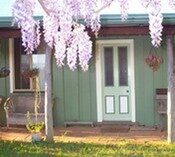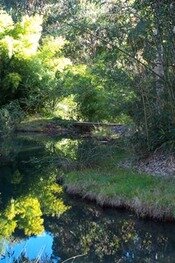To garden and to write about gardening. The technology of the internet has seen the rise of the "blog", the web log. The temptation is to write more than to dig. Here are thoughts on an occasional basis from one who likes to garden, but who finds that the computer can take more time than is realized.
Weeds and People
Weeds and people
One of the Festival garden exhibitors for Autumn said to me the other day, “Wow, the sour sob has suddenly appeared and growing fast, hasn’t it?”
Sour Sob
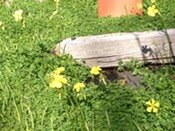
A type of oxalis, it is a classic survivor and hard to eradicate.
I realized looking around my garden a little later that my gardening friend was spot on. A couple of weeks before, no sign of these nuisance plants and then with a bit of rain, shorter days, up they came. In just a few days they were beginning to cover an area, crowding and shading other more genteel and diminutive plants that I would rather have. Sour sob, by the way, is an Oxalis (also known as the Wood Sorrel family) Oxalis pas-caprae, with a nutty bulb or tuber that lies dormant several centimetres below the surface over summer. The Guinea Fowl appear to have discovered them in that they dig down with great gusto to where the bulbs are. The plants are edible in small quantities, though they do contain oxalic acid and can cause oxalate poisoning in sheep.
Sour sob has bright shiny flowers of the purest yellow on cylindrical stalks, with leaflets that resemble clover. It is not just any old weed; it is a Declared Plant which means the landowner is required to control it though it is almost impossible to eradicate with no easy quick fix.
“What’s in a name? that which we call a rose By any other name would smell as sweet.” From Shakespeare’s “Romeo and Juliet”.
What is a weed? To paraphrase the above, “What’s in a name? that which we call a weed By any other name would be as noxious.”
The naming of a plant as a weed is essentially a human invention or construct. A weed is a plant growing where it is not wanted (by us). The plant is neutral in the matter. The plant in its original habitat may have been quite innocuous causing no particular harm or nuisance in its local environment. Then for various reasons it was transported either accidentally or deliberately to a new location, where it found conditions to its liking and thrived. It then began to compete with the local, indigenous plants often outcompeting them and taking over areas, or it began to grown in pasture where it was poisonous to stock. Other plants became weeds of crops or threatened orchards with their abundance.
We now have weeds of wetlands – think of the Arum lily – on sale in florist’s shops, but invasive of many wetland areas near the coast. In the inland South West this lily does not seem to be such a problem, perhaps our hotter summers and colder winters are not so much to its liking.
There are some fascinating contradictions in the weed story. These days with scarcer water supplies and the need to garden in a waterwise way we often look for plants that will tolerate dry conditions over summer and that can survive with minimal summer watering or none at all. Being mindful of fire risk is also essential to making sound choices for garden plants; thus choosing plants of low inflammability is important.
We can seek out plants from the local area or from similar climates; plants that come from South Africa or southern California or from around the Mediterranean. The dog rose (Rosa canina), species gladiolus, Californian poppies, arctotis and ixias are all good examples of plants that are perfectly adapted to our inland South West climate and will work well in gardens. However, these plants are so well adapted that they can become invasive weeds of nearby bushland – they can become garden escapes.
As I was buying bulbs of some of these well-adapted plants the other day, I asked about the potential for the Lachenalias and ixias, that I had bought, to escape from a garden. The reply was that these bulbous plants would stay in a garden if people did not transport them (read dump) beyond the garden. For some plants which spread their seeds by birds carrying them, such as the dog rose, or by wind it is probably simpler not to plant them or to consciously manage them very carefully so they do not spread beyond the garden.
Blackberry was introduced for its delicious, summer fruit, easy to grow!
We need to be careful about what we plant and where we put our garden refuse. The issue of weeds in our area is as much about people as it is about plants.
Another old dependable
Camellias are decorative

Camellias are good flowers for the house, in this case, adding charm to an old bookcase.
A Classic Garden Plant for the inland South West
Whilst exploring an old mill town in the Blackwood Valley, the other day, I noticed a rather dilapidated timber cottage at the end of the road. It was in a large clearing with tall forest trees as a backdrop. Standing alone some distance from the front of the house was a large, solid-looking, dark green shrub. Its otherwise severe look was softened by the fact that it was covered by large bright red blooms. Even from a distance it was easy to see it was a camellia, in fact a Camellia japonica in its full winter splendour.

Quite clearly the camellia bush had been there for many years with little attention and yet it was producing a beautiful crop of blooms. It was obviously surviving and doing quite well. I have seen many examples of fine, old camellias thriving alongside deserted farm houses, or standing with a group of gnarled and venerable fruit trees, the last reminders of a once thriving farm garden.
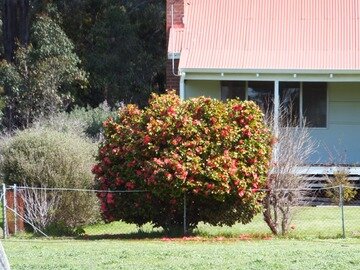
Camellia japonica, for those not familiar with this plant, is the most commonly grown member of the Camellia genus. With its glossy, dark green leaves and contrasting red or white waxy flowers it can grow to the size of a small tree. It is related to the tea plant, Camellia sinensis, and was introduced to England by the mid-eighteenth century, possibly as a substitute for the tea plant. A living tea plant had been keenly sought by traders so that they could grow tea themselves rather than import tea in the dried form from China or other parts of Asia.
The decorative camellia originally came from China where it had long been cultivated, but from early times it had been grown in Japan, hence its botanical name. Revered in both countries, partly because of its winter-flowering characteristic, it was often found in temple gardens. It grows best in a mild winter climate usually on slopes or in tall evergreen forests where it can have protection from the hot summer sun and from winter storms. It dislikes soils with lime, preferring acid soils with surface leaf litter.
Further north around Perth in the sandy soils, camellias can be grown with some success given moderate summer water and preferably protection from the hot afternoon sun. However, here in the heavier, clay-based soils of the central South West, the camellia will succeed even in full sun for most of the day. In Memorial Park at Bridgetown a half-circle of camellias to the west of the War Memorial manages to grow and flower quite well with limited care. Given a little attention and a modicum of summer moisture in a well-kept garden the camellia will excel.
Camellia japonica is thus well suited to growing in many parts of the South West. It is puzzling to see that it is not more widely grown. It gets very few pests or diseases and it has beautiful flowers. Perhaps fashions have changed or the plant is seen as not being sufficiently waterwise. Yet once established in a good position, especially if sheltered from the hot afternoon sun, it can and does grow very well.
One of its characteristics is that it is a relatively slow grower. To reach tree size it might take fifty years or more. This modern life might require plants to grow fast, to give instant gratification. However, it is often the case that the faster a plant grows, the shorter its life span. Take the wattles - fast yes, but after fifteen years or less, the wattle is ready to fall over, or split in a storm and be renewed by seeds or suckers. The camellia on the other hand is a slow and steady grower and has a certain elegance of habit. It will not become gangly, nor likely to drop branches in a storm. It is an excellent garden plant with barbecue flame tests showing that it is not inflammable.
Plant a camellia or two this spring and enjoy the blooms for years to come.
Garden stalwarts
Almond blossom
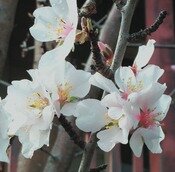
The almond tree with its early spring blossom is literally a classical plant growing in the Mediterranean regions for millennia.
Call them traditional plants or the plants that grandmother used to grow, but there are a number of plants ranging from large trees to small shrubs and, indeed, bulbs which are the great survivors and performers in our mediterranean-climate gardens.
Novice or highly experienced gardeners can select from these types of plants knowing that they will get good garden performance with not too many problems, nor much effort. Not surprisingly the origins of these plants are from climes similar to our own and they are designed to handle the long periods of our dry summer and give us flowers or fruit, and even colour and perfume.
So which plants make the top of the list for performance and reliability? Here are a few to start you thinking - I am sure you will add your own favourites.
The black or Persian mulberry, Morus nigra, is a top plant and from late December and into January it is resplendent with its inimitable fruits. Eaten fresh straight from the tree (and very hard to disguise the fact that you’ve been picking them) they are delicious. If you can refrain from eating them as you pick them, and can gather them in sufficient quantities, they make a beautiful jam or are delicious in tarts.
Whilst a young tree will require watering over the first few summers, once established on deep soils, they will grow with little attention into massive trees that with age will sprawl gently across a paddock, still continuing to produce fruit even after a century. The leaves are well known for providing food for silkworms and thus have a place not only in our gardens but as part of our human history.
Another tree with classic origins is the almond, Prunus dulcis, also a sturdy performer in the garden and, as well as producing one of the best of the nuts, is known as the harbinger of spring. Its blossoms are some of the first to flower in late winter, early spring. They have an elegant beauty - pink buds opening to a pale pink fading to white, five-petalled flowers of a simple form, appearing before the leaves.
The tree is deciduous with the leaves dropping toward the end of summer as a water-saving tactic if the season is particularly dry. Probably a native of western and temperate India and Iran it spread into what is now Israel some four thousand years ago. Later it became well known in southern and middle Europe arriving in Britain some 400 years ago. It was one of the first of the nut trees to be brought to the Swan River Settlement and arrived by the 1830s. It is one of my favourite trees, well worth a place in our gardens even though we can rarely enjoy the almonds. Twenty-eight parrots invariably beat us to the crop.
The spring-flowering rose that resembles a puff of fairy floss with its frilly pink and white petals is often found around old settlements of the South West. It is Rosa indica-major, possibly grown as a stock rose, but also is a pretty rose in its own right. It has long, arching canes with flowers covering the branches in spring.
The fact that this rose survives long after the old homesteads are gone is testament to its toughness. It will grow readily from cuttings, and whilst not usually available from nurseries can often be sourced through friends. This Rosa indica-major is but one of many that perform well in the gardens of the central South West. The low humidity of summer ensures that the shrubs have fewer fungal diseases than in areas with summer rain.
This short list would be incomplete without mention of at least one of the spring-flowering bulbs. Best grown as a veranda plant the Hippeastrum is a type of lily with some resemblance to the Bella Donna lilies, but in a different genus. It is best left to become dormant and slightly dry over winter and protected from severe frost. In spring it produces heads of classically shaped lily flowers in colours ranging from red through pink to white with variations in between. A most rewarding plant with many hybrids, its large flowers are a wonderful sight in a pot near the front door.
We could add many more rewarding plants to this list, such as the fig, the carob, the Chinese elm, the oaks, but the plants described above are a start. They are on the whole easy to grow, do not require heaps of water and are of low inflammability; they are garden stalwarts.

Autumn hints
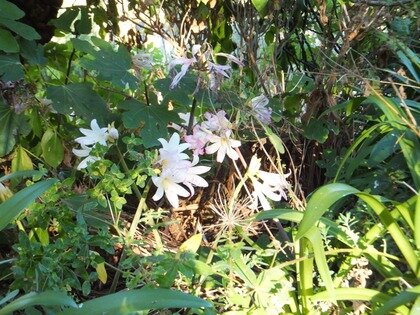
The flowering of the Bella Donna Lilies, often called Naked Ladies, because their flowering stems emerge from the earth before the leaves appear, are a sure sign that Autumn is here.
The days are noticeably shorter. In fact as I write this we are at the equinox. We are looking out for rain with hope that some may fall and dampen the parched and dusty land.
We have picked the last of the peaches. These late varieties are not really cultivars but are probably seedlings, nonetheless they are very acceptable golden fruits that are delicious fresh or lightly poached for freezing and eating later in the depths of winter when summer is but a memory.
With the shorter days and the start of cooler nights we are starting to see leaf fall and some colour in the poplars as they turn to gold. To me this is one of the most attractive times of the year with mild days, little wind and cool nights.
The mellow season.
Summer fruits
For all the storms and tempests we have had this summer with its extremes of temperature, lightning starting bushfires all over the State and a cyclone to keep us on our toes, we have had some much-needed rain and, of course, the ripening of the summer fruits.
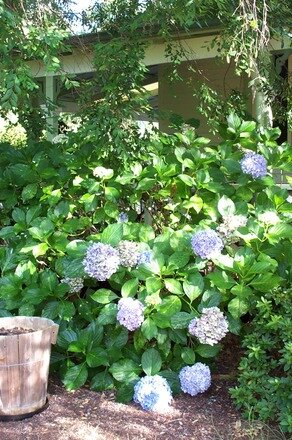
Nectarines and peaches have been the stars with plums as a very acceptable back up fruit. I say back up because the plum is particularly good when cooked in pies and in jams. It is often mixed with fruits such as mulberries, which are low in pectin, to make well-set jams. Speaking of mulberries, they were fruiting for nearly all of January. They are best eaten straight from the tree in the orchard. The young rooster and hens, which are let out into the orchard each morning, learnt very quickly about the delights of mulberries but left some for us.
The typical summer flowers of agapanthus and hydrangeas provide a cooling effect and when kept reasonably moist can form a valuable role as fire retardant plants in a firewise garden.
A very large Chinese Elm has grown even more over summer and is now scraping the roof. Not only is it not very good for the roof structure, it is too easy for it to be dropping leaves and small twigs into the gutters creating a fire hazard. Not good for summer!
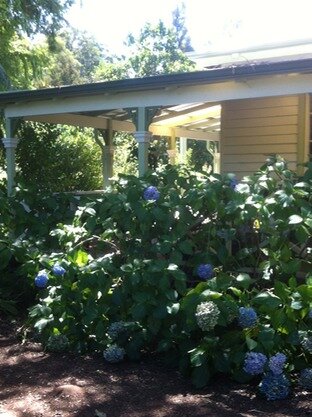
Just last week we have had the Chinese Elm trimmed up and have removed overhanging branches as much as possible whilst still maintaining shade onto the house from the hot afternoon sun.
The photo, right, shows that the elm has been trimmed from the roof and reveals that the gutters do need cleaning to reduce the fire hazard. Photo taken in the middle of the day showing that we still have dappled shade, but there is better fire protection.
The elm, too, is a valuable component of a firewise garden in that it will provide a shield from radiant heat and a filter for embers should there be a bushfire in the vicinity.
In this part of the country a bushfire is quite likely over summer.
Summer: gardens and fires
Whilst most of us hope it won't happen to us, ie that a fire will burn our house and garden, there is always a chance on a hot, windy day that a fire will start in a paddock or in natural bushland and sweep down upon us.
The trigger to start a fire can be one of several: lightning strikes, a carelessly-lit campfire, a discarded butt, burning off to try to reduce fuel that gets away or variations on all of the preceding including arson, of course.
Whatever the trigger, the immediate surrounds of our houses can make a huge difference as to how well we, our house and our garden can survive.
Some plants burn much more readily than others, for example, many of the trees and shrubs of the South West forests of Western Australia are highly inflammable. They are well adapted to fire, indeed many germinate better with the aid of a bushfire.
Plants that are low in resins or oils, that have soft, large leaves containing moisture are not so flammable. Fruit trees, such as apple, plum, fig and peach are less likely to burn readily than a gum tree with the volatile eucalyptus oil in its leaves.
Below is photo showing John in our orchard with a non-inflammable plum to the left, in the process of cutting back a Red-flowering Gum, Corymbia ficifolia. This tree, with its inflammable leaves and dead branches, could burn if embers blew in from nearby bushland during a fire.

An orchard can act like a green firebreak if the plants chosen are unlikely to burn readily. In the centre background is a carob which is an evergreen, fire-retardant small tree.
Wildflower findings
Last Sunday as part of the Festival of Country Gardens we went to the Hester Forest, a few kms east of Bridgetown. The earlier flowering orchids such as donkey orchids and spider orchids had finished, but there were plenty of enamel and sun orchids. The forest had several distinctly different areas with different soil types and corresponding changes in vegetation.

An interesting plant that we came across was the Hooded Lily, Johnsonia lupulina, named because the flowers look rather like the flowers on the European Hop plant. Each of the flower heads is made up of many small lily-type flowers protected by the papery bracts which form an elongated shape with a rather fetching pink tip. We thought it would look very attractive in a garden setting, perhaps with many plants in a cluster or row. The occasional one would also look wonderful in a mixed bed of plants which is how it grows naturally in bushland anyway.
Summer taste
Suddenly the maximum temperature is in the high twenties. My thoughts turn to the need to check out the reticulation system as newly planted shrubs begin to wilt slightly.
The past few months have seen rainfall that is average or even better which after several winters with very low rainfall is a godsend. It has meant that the ground has had a good soaking and that many tanks and dams are full. Our tanks are all topped up and have been for months.
The wildlife, too, is recognizing the seasonal changes. A willy wagtail was chasing off a magpie this morning. Both birds have been foraging for food quite close to the house which suggests that they have young mouths to feed and are not to bothered by our presence.
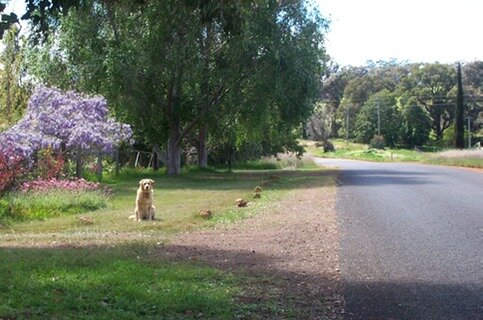
Another appearance though not so welcome was sighting of a large dugite, sunning itself at the corner of the Open Shed just metres from our back steps. We instantly think of the dog and the danger to her. The snake ducked back under the shed when it saw me, but a few minutes later it was back out. It was a hot morning and I suspect it was seeking water. A little later it decided to move towards the poultry pens where there is water and in stretching itself out to travel, showed itself to be at least 1.5 metres long. Quite beautiful with its small head and amazing convoluting body, a dark olively, brown colour. Possibly just coming out of hibernation, hungry and with its venom at its most concentrated.
Joanna, (left, ouside Montaza Park) who is a Labrador/Golden Retriever cross, is a natural hunting dog and inquisitive. Not great if there are snakes about, we have already had one emergency visit to the Vet last summer, when we saw Joanna confronting a very large dugite. Fortunately, she was not bitten. Ah ... the quiet life of the country.
Spring gallops
Not only are there spring carnivals as the horse racing season progresses with plenty of galloping horses, so, too, do the gardens accelerate with their spring growth. Flower buds, leaf buds all are springing (sorry!) into action.
Montaza Park jasmine

Jasminum polyanthemum is a perfumed twining creeper with pretty perfumed flowers.
The poplar that was bare last week is now covered with fresh, young leaves, the Mediterranean Oak is now fully clothed and casting solid (almost too solid) shade.
Cherry blossom is out as are varieties of apples. And the roses, especially many of the older style varieties such as the Tea Roses, are full of blooms.
Climbers, such as the pretty jasmine, left, are trailing over fences and, if given a chance will climb into trees. It is best, for the tree's sake to keep climbers, like jasmine, under control as they can smother the tree. An annual prune in late summer is not a bad idea as it will keep the jasmine from wrecking other plants.
The central part of the South West of Western Australia has a warm temperate climate. In inland parts, and dependant on altitude, frosts may occur several times a winter, sufficiently cold in some years to adversely affect plants such as Jacarandas and kill geraniums.
Lilac at Montaza Park

The flowers and scent of lilac are a sign of spring.
Plants from colder climes that tolerate frost take the occasional cold morning in their stride and will do well. Apples and other similar fruits rely on the chill factor to fruit well.
Lilacs are good examples, that although from a colder climate, they will grow and bloom well in the inland South West especially if they have some protection from the hot afternoon summer sun.
Now to the gardening
At last, after what seems like months, but with most of the energy concentrated in the past fortnight the programme of the Festival of Country Gardens has been compiled by yours truly, ie Peta Townsing, who is the Festival coordinator till the end of this year and chair of Blackwood Country Gardens Inc which is the association that stages the Festival.
In the past five days the programme for the Festival has been organized into a brochure using such software as Quark Express, Adobe Illustrator (a bit mysterious), Photoshop (good fun) and the more mundane office software such as Exel for creating tables and then converting most of this to pdf.
The whole document is then converted from Quark into a pdf for sending to the Prepress people for creating film to send to the printers in the four colours used: Cyan, Magenta, Yellow and Black.
By the end of September we will be collecting 5000 copies of a DL sized brochure which will contain the main details of the Festival of Country Gardens for spring.
Meantime it is available as a low resolution form with a smaller file size that can be viewed on line and then printed if desired. This form comes as a "spread" as though the pages are opened out for easy printing on A4 sized sheets of paper.
Of course in the past couple of weeks we have had both warm weather and some rain which the weeds, knowing that I am busy, have been making the most of my not being amongst them and have grown exceeding well. So it will be out with the mower, the gardening gloves, the mulching, damp newspapers and the mini-pick to get on top of the weeds before they get on top of me!
Hope you enjoy the programme brochure and that there are not too many typos. There is an error on the map in finding the Equinox garden in Donnybrook - Google is not always accurate and that will be remedied on line at least.

The wisteria is out in the front garden of the Cottage. It seems a bit early, but maybe the warm days of recent weeks have brought on the flowering.
Happy gardening.


